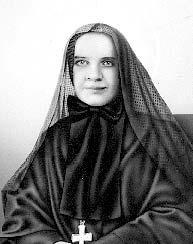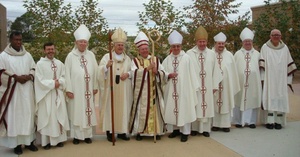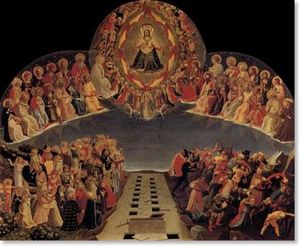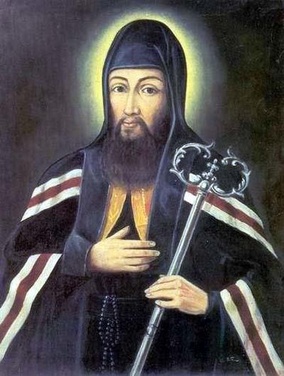May the memory of the deceased monks, nuns, sisters, and oblates be eternal.
Priest bites off priest’s ear
This story is so sad that it’s so funny. An Australian priest bites off another priest’s ear –over a parking space. The biter is 80 years old and the bitten is 81. Read about it. Really, Fathers….?
Saint Frances Xavier Cabrini
 Mother Frances Cabrini, the first US citizen to be canonized by the Church spent a night with the
Mother Frances Cabrini, the first US citizen to be canonized by the Church spent a night with the
Benedictine sisters at Mount Saint Scholastica in Atchison, Kansas.
winter of 1902 the new convent and the new chapel had a special visitor. Mother
Frances Xavier Cabrini, traveling west, stopped over night. Sister Barbara
loved to recall: ‘She was a very nice ordinary Sister. She liked coffee.'”
her way to Denver to care for the Italian immigrants.)
without tiring, for the salvation of mankind does not depend on material
success; nor on sciences that cloud the intellect. Neither does it depend on
arms and human industries, but on Jesus alone.”
Connecticut lawmakers to consider physician assisted suicide
The front page
of today’s New Haven Register carried an article by Jordan Fenster,
“Right-to-die bill may be discussed by legislature” by which the citizens of
Connecticut were alerted to the possibility that in the next session of the
legislature the question of assisted suicide will be on the table. Following
the defeat of Massachusetts ballot on the same subject last week, the contagion is now again flowing south. Already three US states, Oregon, Montana and Washington, allow for
physician assisted suicide. 34 states prohibit lethal doses of medication that
would end human life.
Let me say from the outset, this is not a Catholic issue. Persons of belief and unbelief ought to be concerned about the potential passing of a law that legalizes medically induced suicide. Hence, this is not a conservative issue. This is not a an anti-human dignity issue. It
is just the opposite: this is a human issue. Who we are a human beings, and how
we teach each other is a human issue that is informed by what we believe and
how we behave. Committing this legislative error is a problem of education.
Recall that in the past when a similar bill was brought to the CT voters it failed only 51-49%.
Several weeks ago there appeared in the New York Times an
intriguing OP-ED article that I believe we need to seriously consider in the
discussion of physician assisted suicide. Considering voices that differ from ours need to be thoughtfully taken into account because we are people use who reason to frame our moral lives. We can’t simply dismiss the other and therefore I appeal to people of belief and unbelief to reasonably discuss what’s at stake. When we rush the discuss without fact we always get burned.
In my opinion not enough attention has been devoted
to considering how this legislation has been lived out in this country and in
others, nor have we considered the philosophical, theological, sociological and
human consequences of such an act. Most often our heart-strings are pulled, even stretched leading us to decide weighty matters without due attention to the reality in front of us –to the person and people and intimately connected with life and death issues. We also don’t always adequately consider the eternal consequences of killing someone before natural death happens.
Who’s life are we “making dignified” by engaging death before it’s naturally
presented? What really is human dignity? What does it mean to be truly a man or
a woman in relationship with other men and women here-and-now, and following
death? To what extent does fear, anxiety and perceived suffering dictate how we
think and act toward others? Are we sufficiently aware of and sensitive to the difference between ideology and being a person, no matter how debilitated?
Here is Ben Mattlin’s October 31, 2012 New York
Times article published online.
Suicide by Choice? Not So Fast
Continue reading Connecticut lawmakers to consider physician assisted suicide
New Norbertine abbot blessed
 The Nortbertine Order is not that well known in the USA, though it is a venerable way of living one’s vocation: canons praying the Divine Office, living together in community, and being apostolically engaged in the local Church.
The Nortbertine Order is not that well known in the USA, though it is a venerable way of living one’s vocation: canons praying the Divine Office, living together in community, and being apostolically engaged in the local Church.
In the USA, we have the primary Norbertines abbeys of St Norbert’s Abbey (WI), Daylesford Abbey (PA), St Michael’s (CA) and now Santa Maria de la Vid (NM). There are several other priories of Norbertine canons but I want to highlight the recent abbatial blessing of Joel Garner as the first abbot of Santa Maria.
May the Blessed Virgin and Saint Norbert to continue to richly bless Abbot Joel and his community through their intercession before the Throne of Grace.
New York Encounter 2013 – Experiencing Freedom
The New York Encounter 2013 is forthcoming on 18-20
January 2013. The theme for this year’s Encounter is “Experiencing Freedom.”
together a wonderful moment of witness and education. Please find information
for the New York Encounter from the organizers.
Benedictine All Saints
 Today is the liturgical observance of Benedictine All Saints. Let’s pray for all those monks, nuns, sisters and oblates who lived a life of holiness and perseverance in the monastic life.
Today is the liturgical observance of Benedictine All Saints. Let’s pray for all those monks, nuns, sisters and oblates who lived a life of holiness and perseverance in the monastic life.
Saint Josaphat Kuncevyc
 Today, with the feast of Saint Josaphat (c. 1580-1623), we ought to mourn the sad division of the Church that exists between East and West.
Today, with the feast of Saint Josaphat (c. 1580-1623), we ought to mourn the sad division of the Church that exists between East and West.
Cardinal Dolan tells US bishops: work on your own conversion first
The USCCB
President Timothy Cardinal Dolan began his address saying that we need to
attend to “First things first: we are first believers in Christ: the way, the
truth and the life…We need to recall that the Lord said, “Seek first the
Kingdom of God”: it is God who first engages us…”
Continue reading Cardinal Dolan tells US bishops: work on your own conversion first
Dorothy Day’s cause for canonization by US bishops
The Servant of God Dorothy Day’s cause for canonization may move forward (or not) depending on how the vote goes. The bishops of USA are meeting this week in Baltimore for the annual business meeting.



